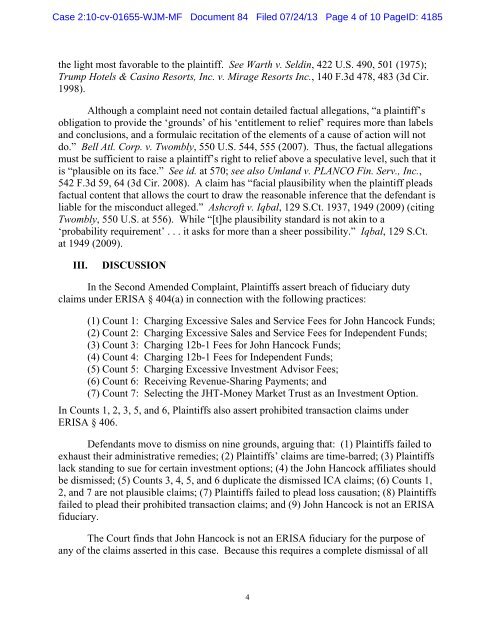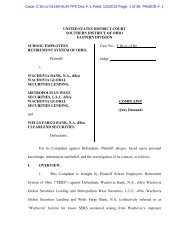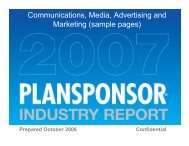Santomenno v. John Hancock Life Ins. Co. - PLANSPONSOR.com
Santomenno v. John Hancock Life Ins. Co. - PLANSPONSOR.com
Santomenno v. John Hancock Life Ins. Co. - PLANSPONSOR.com
You also want an ePaper? Increase the reach of your titles
YUMPU automatically turns print PDFs into web optimized ePapers that Google loves.
Case 2:10-cv-01655-WJM-MF Document 84 Filed 07/24/13 Page 4 of 10 PageID: 4185the light most favorable to the plaintiff. See Warth v. Seldin, 422 U.S. 490, 501 (1975);Trump Hotels & Casino Resorts, Inc. v. Mirage Resorts Inc., 140 F.3d 478, 483 (3d Cir.1998).Although a <strong>com</strong>plaint need not contain detailed factual allegations, “a plaintiff’sobligation to provide the ‘grounds’ of his ‘entitlement to relief’ requires more than labelsand conclusions, and a formulaic recitation of the elements of a cause of action will notdo.” Bell Atl. <strong>Co</strong>rp. v. Twombly, 550 U.S. 544, 555 (2007). Thus, the factual allegationsmust be sufficient to raise a plaintiff’s right to relief above a speculative level, such that itis “plausible on its face.” See id. at 570; see also Umland v. PLANCO Fin. Serv., Inc.,542 F.3d 59, 64 (3d Cir. 2008). A claim has “facial plausibility when the plaintiff pleadsfactual content that allows the court to draw the reasonable inference that the defendant isliable for the misconduct alleged.” Ashcroft v. Iqbal, 129 S.Ct. 1937, 1949 (2009) (citingTwombly, 550 U.S. at 556). While “[t]he plausibility standard is not akin to a‘probability requirement’ . . . it asks for more than a sheer possibility.” Iqbal, 129 S.Ct.at 1949 (2009).III.DISCUSSIONIn the Second Amended <strong>Co</strong>mplaint, Plaintiffs assert breach of fiduciary dutyclaims under ERISA § 404(a) in connection with the following practices:(1) <strong>Co</strong>unt 1: Charging Excessive Sales and Service Fees for <strong>John</strong> <strong>Hancock</strong> Funds;(2) <strong>Co</strong>unt 2: Charging Excessive Sales and Service Fees for Independent Funds;(3) <strong>Co</strong>unt 3: Charging 12b-1 Fees for <strong>John</strong> <strong>Hancock</strong> Funds;(4) <strong>Co</strong>unt 4: Charging 12b-1 Fees for Independent Funds;(5) <strong>Co</strong>unt 5: Charging Excessive Investment Advisor Fees;(6) <strong>Co</strong>unt 6: Receiving Revenue-Sharing Payments; and(7) <strong>Co</strong>unt 7: Selecting the JHT-Money Market Trust as an Investment Option.In <strong>Co</strong>unts 1, 2, 3, 5, and 6, Plaintiffs also assert prohibited transaction claims underERISA § 406.Defendants move to dismiss on nine grounds, arguing that: (1) Plaintiffs failed toexhaust their administrative remedies; (2) Plaintiffs’ claims are time-barred; (3) Plaintiffslack standing to sue for certain investment options; (4) the <strong>John</strong> <strong>Hancock</strong> affiliates shouldbe dismissed; (5) <strong>Co</strong>unts 3, 4, 5, and 6 duplicate the dismissed ICA claims; (6) <strong>Co</strong>unts 1,2, and 7 are not plausible claims; (7) Plaintiffs failed to plead loss causation; (8) Plaintiffsfailed to plead their prohibited transaction claims; and (9) <strong>John</strong> <strong>Hancock</strong> is not an ERISAfiduciary.The <strong>Co</strong>urt finds that <strong>John</strong> <strong>Hancock</strong> is not an ERISA fiduciary for the purpose ofany of the claims asserted in this case. Because this requires a <strong>com</strong>plete dismissal of all4







